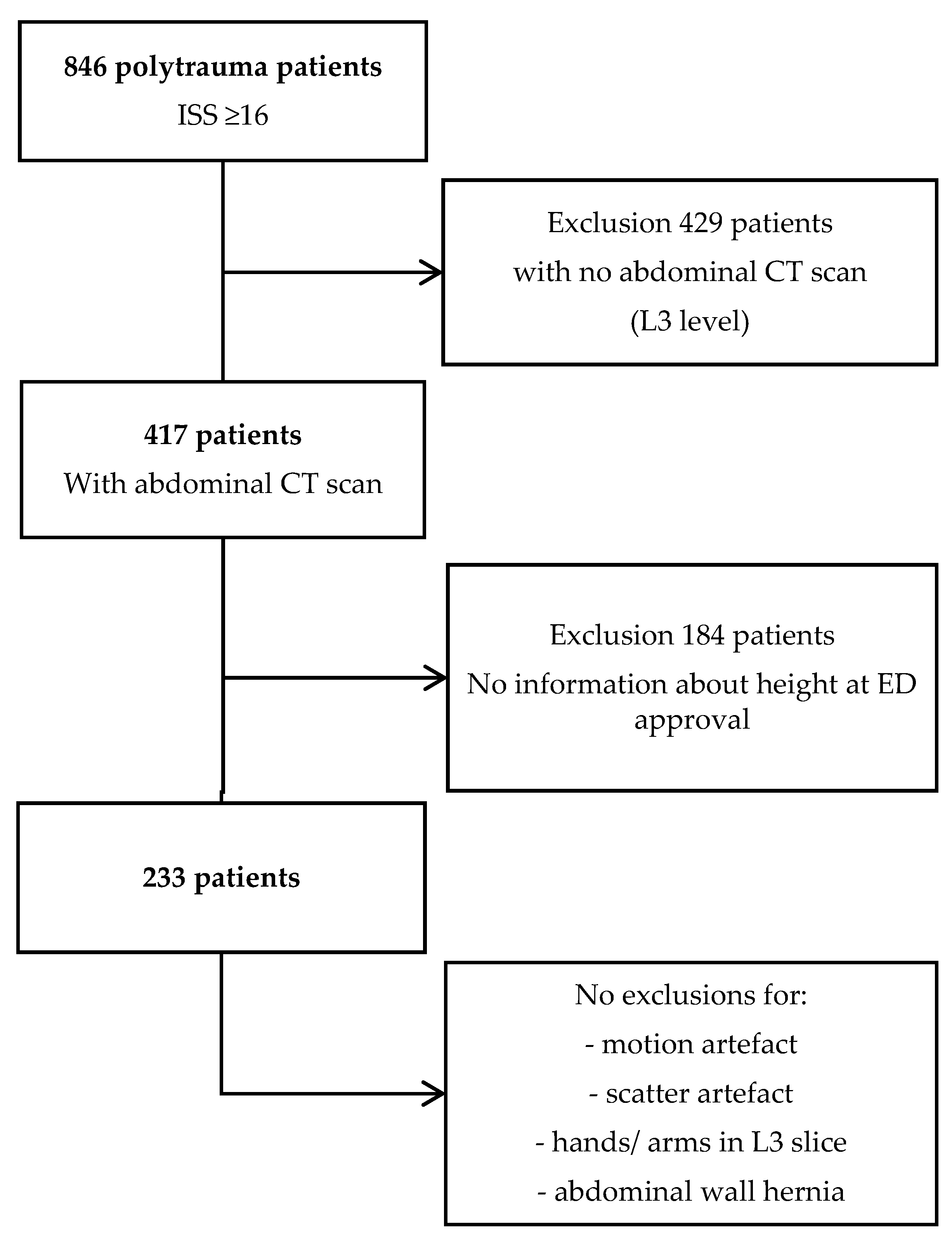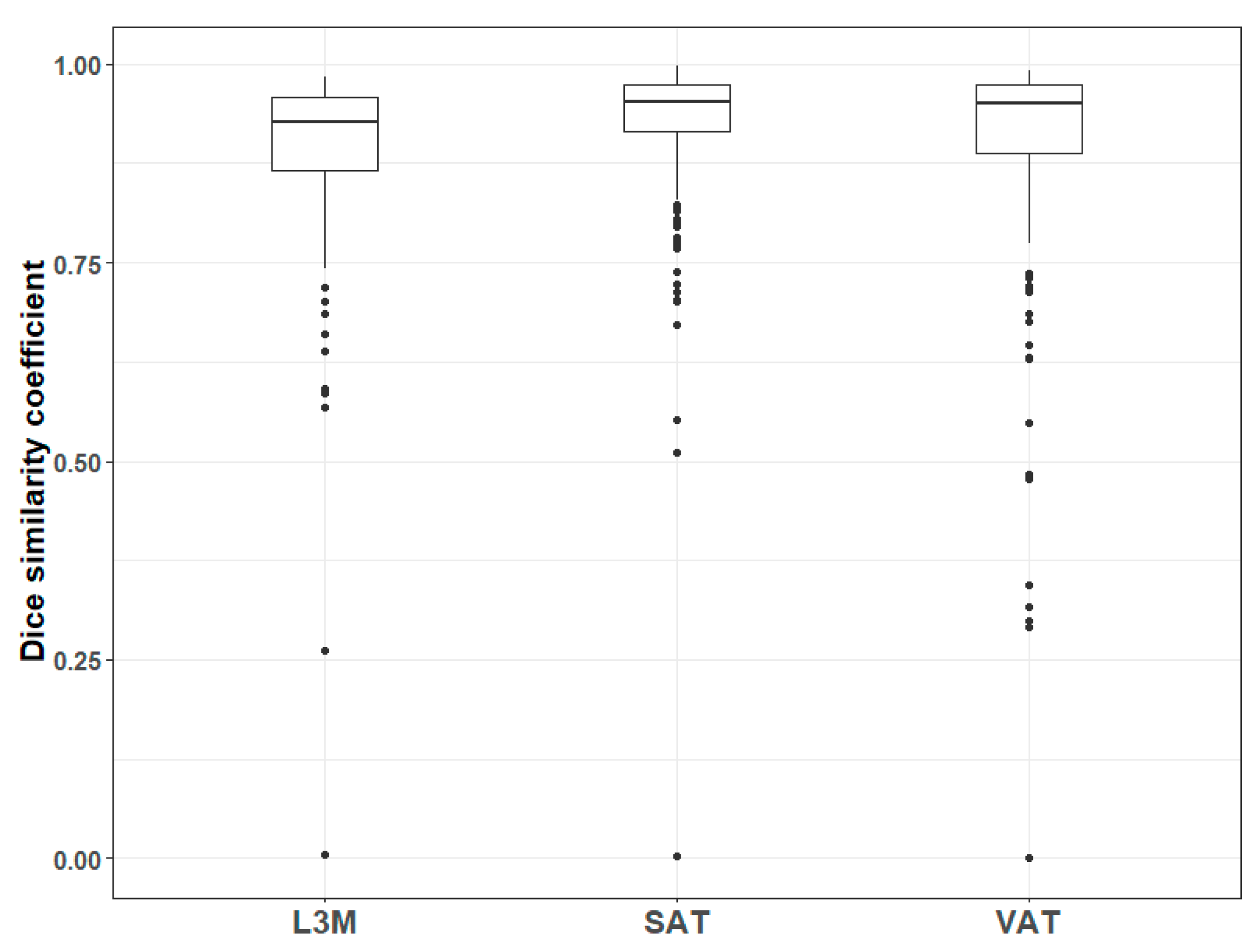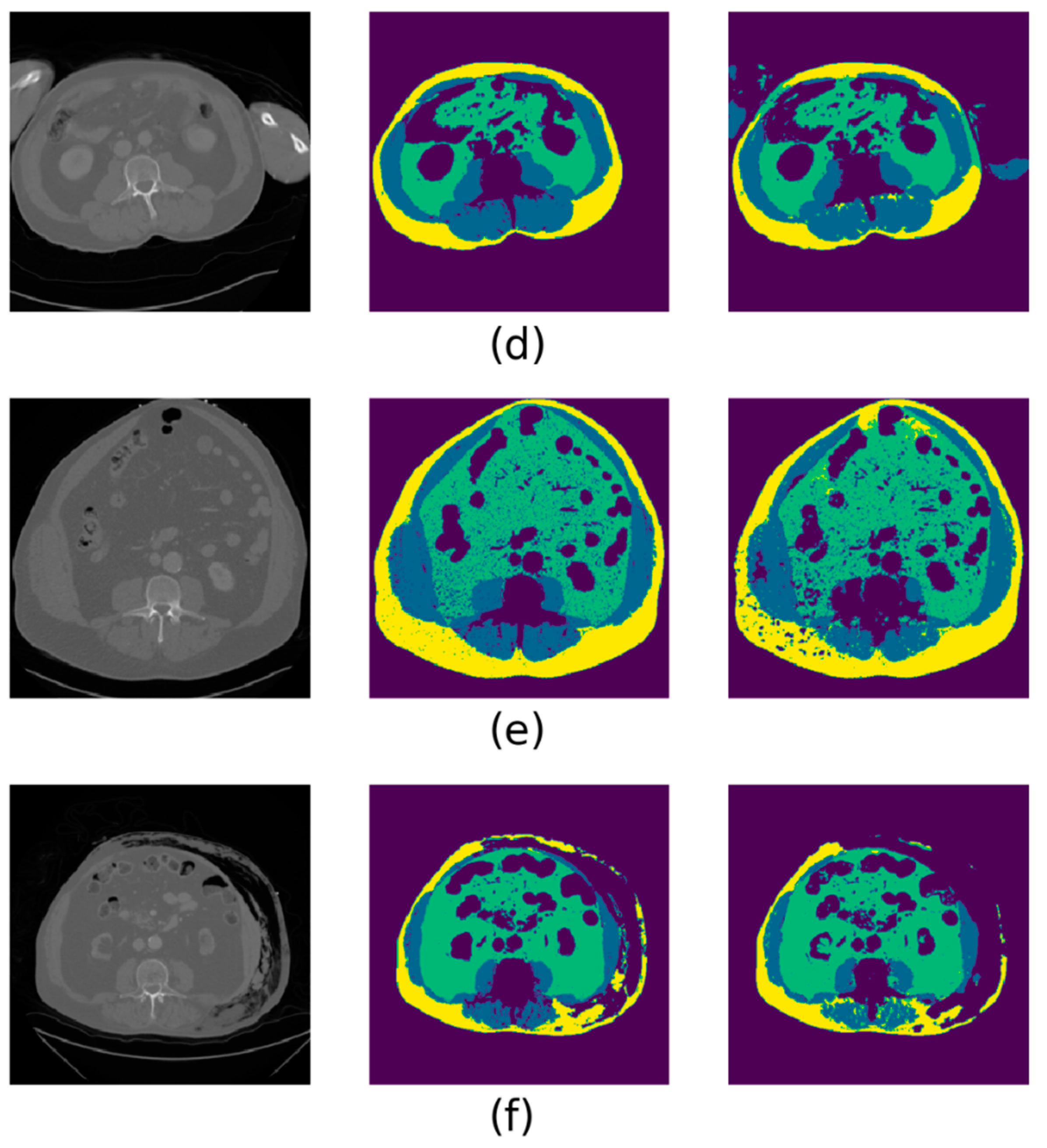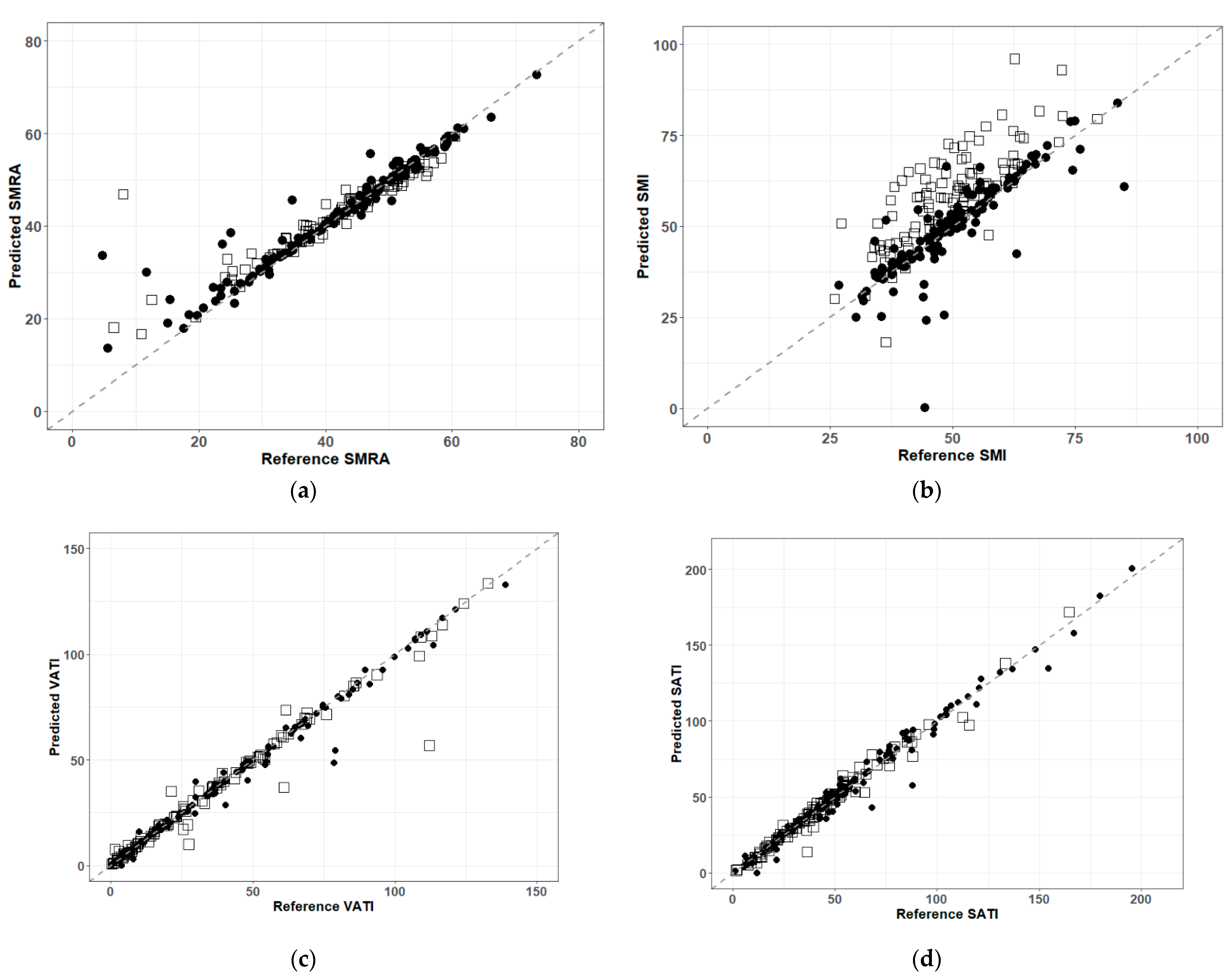Deep Learning Automated Segmentation for Muscle and Adipose Tissue from Abdominal Computed Tomography in Polytrauma Patients
Abstract
1. Introduction
2. Materials and Methods
2.1. Training and Validation Set: Cancer Surgery Cases
2.2. Independent Test Set: Polytrauma Cases
2.3. Deep Learning
2.4. Performance Statistics
3. Results
3.1. Similarity of Segmentation
3.2. Agreement Analysis
4. Discussion
5. Conclusions
Supplementary Materials
Author Contributions
Funding
Institutional Review Board Statement
Informed Consent Statement
Data Availability Statement
Acknowledgments
Conflicts of Interest
References
- Thibault, R.; Pichard, C. The evaluation of body composition: A useful tool for clinical practice. Ann. Nutr. Metab. 2012, 60, 6–16. [Google Scholar] [CrossRef] [PubMed]
- Gonzalez, M.C.; Pastore, C.A.; Orlandi, S.P.; Heymsfield, S.B. Obesity paradox in cancer: New insights provided by body composition. Am. J. Clin. Nutr. 2014, 99, 999–1005. [Google Scholar] [CrossRef] [PubMed]
- Sheetz, K.H.; Waits, S.A.; Terjimanian, M.N.; Sullivan, J.; Campbell, D.A.; Wang, S.C.; Englesbe, M.J. Cost of major surgery in the sarcopenic patient. J. Am. Coll. Surg. 2013, 217, 813–818. [Google Scholar] [CrossRef]
- Cruz-Jentoft, A.J.; Bahat, G.; Bauer, J.; Boirie, Y.; Bruyere, O.; Cederholm, T.; Cooper, C.; Landi, F.; Rolland, Y.; Sayer, A.A.; et al. Sarcopenia: Revised European consensus on definition and diagnosis. Age Ageing 2019, 48, 16–31. [Google Scholar] [CrossRef]
- Lee, K.; Shin, Y.; Huh, J.; Sung, Y.S.; Lee, I.-S.; Yoon, K.-H.; Kim, K.W. Recent Issues on Body Composition Imaging for Sarcopenia Evaluation. Korean J. Radiol. 2019, 20, 205–217. [Google Scholar] [CrossRef]
- Sergi, G.; Trevisan, C.; Veronese, N.; Lucato, P.; Manzato, E. Imaging of sarcopenia. Eur. J. Radiol. 2016, 85, 1519–1524. [Google Scholar] [CrossRef] [PubMed]
- Engelke, K.; Museyko, O.; Wang, L.; Laredo, J.-D. Quantitative analysis of skeletal muscle by computed tomography imaging—State of the art. J. Orthop. Transl. 2018, 15, 91–103. [Google Scholar] [CrossRef]
- Sharma, P.; Zargar-Shoshtari, K.; Caracciolo, J.T.; Fishman, M.; Poch, M.A.; Pow-Sang, J.; Sexton, W.J.; Spiess, P.E. (Eds.) Sarcopenia as a predictor of overall survival after cytoreductive nephrectomy for metastatic renal cell carcinoma. In Urologic Oncology: Seminars and Original Investigations; Elsevier: Amsterdam, The Netherlands, 2015. [Google Scholar]
- Prado, C.M.; Lieffers, J.R.; McCargar, L.J.; Reiman, T.; Sawyer, M.B.; Martin, L.; Baracos, V.E. Prevalence and clinical implications of sarcopenic obesity in patients with solid tumours of the respiratory and gastrointestinal tracts: A population-based study. Lancet Oncol. 2008, 9, 629–635. [Google Scholar] [CrossRef]
- Baracos, V.E.; Mazurak, V.C.; Bhullar, A.S. Cancer cachexia is defined by an ongoing loss of skeletal muscle mass. Ann. Palliat. Med. 2018, 8, 3–12. [Google Scholar] [CrossRef]
- Shen, W.; Punyanitya, M.; Wang, Z.; Gallagher, D.; St.-Onge, M.-P.; Albu, J.; Heymsfield, S.B.; Heshka, S. Total body skeletal muscle and adipose tissue volumes: Estimation from a single abdominal cross-sectional image. J. Appl. Physiol. 2004, 97, 2333–2338. [Google Scholar] [CrossRef] [PubMed]
- Baumgartner, R.N.; Koehler, K.M.; Gallagher, D.; Romero, L.; Heymsfield, S.B.; Ross, R.R.; Garry, P.J.; Lindeman, R.D. Epidemiology of sarcopenia among the elderly in New Mexico. Am. J. Epidemiol. 1998, 147, 755–763. [Google Scholar] [CrossRef] [PubMed]
- Sinelnikov, A.; Qu, C.; Fetzer, D.T.; Pelletier, J.S.; Dunn, M.A.; Tsung, A.; Furlan, A. Measurement of skeletal muscle area: Comparison of CT and MR imaging. Eur. J. Radiol. 2016, 85, 1716–1721. [Google Scholar] [CrossRef] [PubMed]
- Anthimopoulos, M.; Christodoulidis, S.; Ebner, L.; Christe, A.; Mougiakakou, S. Lung Pattern Classification for Interstitial Lung Diseases Using a Deep Convolutional Neural Network. IEEE Trans. Med. Imaging 2016, 35, 1207–1216. [Google Scholar] [CrossRef]
- Hemke, R.; Buckless, C.G.; Tsao, A.; Wang, B.; Torriani, M. Deep learning for automated segmentation of pelvic muscles, fat, and bone from CT studies for body composition assessment. Skelet. Radiol. 2020, 49, 387–395. [Google Scholar] [CrossRef]
- Lee, H.; Troschel, F.M.; Tajmir, S.; Fuchs, G.; Mario, J.; Fintelmann, F.J.; Do, S. Pixel-Level Deep Segmentation: Artificial Intelligence Quantifies Muscle on Computed Tomography for Body Morphometric Analysis. J. Digit. Imaging 2017, 30, 487–498. [Google Scholar] [CrossRef] [PubMed]
- Burns, J.E.; Yao, J.; Chalhoub, D.; Chen, J.J.; Summers, R.M. A Machine Learning Algorithm to Estimate Sarcopenia on Abdominal CT. Acad. Radiol. 2020, 27, 311–320. [Google Scholar] [CrossRef] [PubMed]
- Paris, M.T.; Tandon, P.; Heyland, D.K.; Furberg, H.; Premji, T.; Low, G.; Mourtzakis, M. Automated body composition analysis of clinically acquired computed tomography scans using neural networks. Clin. Nutr. 2020, 39, 3049–3055. [Google Scholar] [CrossRef]
- Weston, A.D.; Korfiatis, P.; Kline, T.L.; Philbrick, K.A.; Kostandy, P.; Sakinis, T.; Sugimoto, M.; Takahashi, N.; Erickson, B.J. Automated Abdominal Segmentation of CT Scans for Body Composition Analysis Using Deep Learning. Radiology 2019, 290, 669–679. [Google Scholar] [CrossRef] [PubMed]
- Beenen, L.F.; Sierink, J.C.; Kolkman, S.; Nio, C.Y.; Saltzherr, T.P.; Dijkgraaf, M.G.; Goslings, J.C. Split bolus technique in polytrauma: A prospective study on scan protocols for trauma analysis. Acta Radiol. 2015, 56, 873–880. [Google Scholar] [CrossRef]
- Stassen, R.C.; Reisinger, K.W.; Al-Ali, M.; Poeze, M.; Ten Bosch, J.A.; Blokhuis, T.J. High Prevalence of Sarcopenia in Older Trauma Patients: A Pilot Study. J. Clin. Med. 2020, 9, 2046. [Google Scholar] [CrossRef]
- Bridgewater, J.A.; Pugh, S.A.; Maishman, T.; Eminton, Z.; Mellor, J.; Whitehead, A.; Stanton, L.; Radford, M.; Corkhill, A.; Griffiths, G.O.; et al. Systemic chemotherapy with or without cetuximab in patients with resectable colorectal liver metastasis (New EPOC): Long-term results of a multicentre, randomised, controlled, phase 3 trial. Lancet Oncol. 2020, 21, 398–411. [Google Scholar] [CrossRef]
- Rutten, I.J.; Ubachs, J.; Kruitwagen, R.F.; van Dijk, D.P.; Beets-Tan, R.G.; Massuger, L.F.; Olde Damink, S.W.; Van Gorp, T. The influence of sarcopenia on survival and surgical complications in ovarian cancer patients undergoing primary debulking surgery. Eur. J. Surg. Oncol. 2017, 43, 717–724. [Google Scholar] [CrossRef]
- Rutten, I.J.; van Dijk, D.P.; Kruitwagen, R.F.; Beets-Tan, R.G.; Olde Damink, S.W.; van Gorp, T. Loss of skeletal muscle during neoadjuvant chemotherapy is related to decreased survival in ovarian cancer patients. J. Cachexia Sarcopenia Muscle 2016, 7, 458–466. [Google Scholar] [CrossRef]
- sliceOmatic. Alberta Protocol. 11 February 2017. Available online: https://tomovision.com/Sarcopenia_Help/index.htm (accessed on 20 January 2021).
- Janssen, I.; Heymsfield, S.B.; Ross, R. Low relative skeletal muscle mass (sarcopenia) in older persons is associated with functional impairment and physical disability. J. Am. Geriatr. Soc. 2002, 50, 889–896. [Google Scholar] [CrossRef]
- Ronneberger, O.; Fischer, P.; Brox, T. (Eds.) U-Net: Convolutional Networks for Biomedical Image Segmentation; Springer International: New York, NY, USA, 2015. [Google Scholar]
- Ioffe, S.; Szegedy, C. Batch Normalization: Accelerating Deep Network Training by Reducing Internal Covariate Shift. arXiv 2015, arXiv:abs/1502.03167. [Google Scholar]
- Srivastava, N.; Hinton, G.; Krizhevsky, A.; Sutskever, I.; Salakhutdinov, R. Dropout: A simple way to prevent neural networks from overfitting. J. Mach. Learn. Res. 2014, 15, 1929–1958. [Google Scholar]
- Krogh, A.; Hertz, J.A. A simple weight decay can improve generalization. In Proceedings of the 4th International Conference on Neural Information Processing Systems, Denver, CO, USA, 2–5 December 1991; pp. 950–957. [Google Scholar]
- He, K.; Zhang, X.; Ren, S.; Sun, J. Delving Deep into Rectifiers: Surpassing Human-Level Performance on ImageNet Classification. In Proceedings of the 2015 IEEE International Conference on Computer Vision (ICCV), Santiago, Chile, 7–13 December 2015; pp. 1026–1034. [Google Scholar]
- Kingma, D.P.; Ba, J. Adam: A Method for Stochastic Optimization. arXiv 2014, arXiv:abs/1412.6980. [Google Scholar]
- Lawrence, I.K.L. A Concordance Correlation Coefficient to Evaluate Reproducibility. Biometrics 1989, 45, 255–268. [Google Scholar] [CrossRef]
- Bland, J.M.; Altman, D.G. Statistical methods for assessing agreement between two methods of clinical measurement. Lancet 1986, 1, 307–310. [Google Scholar] [CrossRef]
- R Core Team. R: A Language and Environment for Statistical Computing. R Foundation for Statistical Computing. 2020. Available online: https://www.R-project.org/ (accessed on 20 January 2021).
- “epiR” Library. Available online: https://rdrr.io/cran/epiR/ (accessed on 20 January 2021).
- Wang, Y.; Qiu, Y.; Thai, T.; Moore, K.; Liu, H.; Zheng, B. A two-step convolutional neural network based computer-aided detection scheme for automatically segmenting adipose tissue volume depicting on CT images. Comput. Methods Programs Biomed. 2017, 144, 97–104. [Google Scholar] [CrossRef] [PubMed]
- Chung, H.; Cobzas, D.; Birdsell, L.; Lieffers, J.; Baracos, V. Automated Segmentation of Muscle and Adipose Tissue on CT Images for Human Body Composition Analysis; SPIE: Bellingham, WA, USA, 2009. [Google Scholar]
- Beaudart, C.; Dawson, A.; Shaw, S.C.; Harvey, N.C.; Kanis, J.A.; Binkley, N.; Reginster, J.Y.; Chapurlat, R.; Chan, D.C.; Bruyère, O.; et al. Nutrition and physical activity in the prevention and treatment of sarcopenia: Systematic review. Osteoporos. Int. 2017, 28, 1817–1833. [Google Scholar] [CrossRef] [PubMed]





| Patient Characteristics | Training Set | Test Set | ||||||
|---|---|---|---|---|---|---|---|---|
| Total | n = 3413 | n = 233 | ||||||
| Mean SNR | 0.9 | 1.1 | ||||||
| Mean CNR | 2.0 | 0.8 | ||||||
| Disease | Colorectal cancer | Ovarian cancer | Pancreatic cancer | Polytrauma patients | ||||
| Study | newEPOC * | FROG’s * | Zuyderland | Zuyderland | MUMC ** | Aachen *** | MUMC | |
| Year | 2007–2012 | 2017–2019 | 2013–2017 | 2013–2017 | 2002–2015 | 2004–2014 | 2010–2017 | 2015–2019 |
| Total | 153 | 804 | 226 | 1587 | 216 | 123 | 304 | 233 |
| Male | - | 374 (58%) | - | 883 (56%) | 0 | 0 | 161 (53%) | 156 (66.9%) |
| Female | - | 430 (42%) | - | 704 (44%) | 216 (100%) | 123 (100%) | 143 (47%) | 77 (33.1%) |
| Age (years) | - | 25–95 (mean 68.2) | - | 32–93 (median: 70) | 30–101 | 39–86 | mean 67.7 (SD 10.2) | 10–88 (mean 74) |
| BMI (kg/m2) | - | 13.7–58.1 (mean 26.4) | - | 1553 (median: 26) | - | - | 25.4 (SD 4.2) | 13.2–45.7 (mean 29.5) |
| Concordance Correlation | Bias Correction Error | Limits of Agreement | |
|---|---|---|---|
| SMRA | |||
| All | 0.92 (0.91–0.94) | 0.98 | −0.99 (−9.3–7.3) HU |
| Sub: hands | 0.89 (0.85–0.92) | 0.96 | −1.0 (−10–8.2) HU |
| Sub: no hands | 0.95 (0.93–0.96) | 0.99 | −0.97 (−8.5–6.6) HU |
| SMI | |||
| All | 0.71 (0.64–0.76) | 0.93 | −4.0 (−21–13) kg·m−2 |
| All (interobs.) | 0.88 (0.86–0.91) | 0.97 | −2.7 (−12–6.3) kg·m−2 |
| Sub: hands | 0.58 (0.48–0.67) | 0.74 | −9.4 (−25–6.2) kg·m−2 |
| Sub: no hands | 0.83 (0.77–0.88) | 0.99 | −0.69 (−28–29) kg·m−2 |
| VATI | |||
| All | 0.99 (0.98–0.99) | 1.00 | 0.98 (−9.7–12) kg·m−2 |
| Sub: hands | 0.98 (0.97–0.98) | 1.00 | 0.87 (−12–14) kg·m−2 |
| Sub: no hands | 0.99 (0.99–0.99) | 1.00 | 1.1 (−7.0–9.1) kg·m−2 |
| SATI | |||
| All | 0.99 (0.98–0.99) | 1.00 | 0.29 (−9.8–10) kg·m−2 |
| Sub: hands | 0.99 (0.98–0.99) | 1.00 | 0.00 (−9.2–9.2) kg·m−2 |
| Sub: no hands | 0.99 (0.98–0.99) | 1.00 | 0.52 (−10–11) kg·m−2 |
Publisher’s Note: MDPI stays neutral with regard to jurisdictional claims in published maps and institutional affiliations. |
© 2021 by the authors. Licensee MDPI, Basel, Switzerland. This article is an open access article distributed under the terms and conditions of the Creative Commons Attribution (CC BY) license (http://creativecommons.org/licenses/by/4.0/).
Share and Cite
Ackermans, L.L.G.C.; Volmer, L.; Wee, L.; Brecheisen, R.; Sánchez-González, P.; Seiffert, A.P.; Gómez, E.J.; Dekker, A.; Ten Bosch, J.A.; Olde Damink, S.M.W.; et al. Deep Learning Automated Segmentation for Muscle and Adipose Tissue from Abdominal Computed Tomography in Polytrauma Patients. Sensors 2021, 21, 2083. https://doi.org/10.3390/s21062083
Ackermans LLGC, Volmer L, Wee L, Brecheisen R, Sánchez-González P, Seiffert AP, Gómez EJ, Dekker A, Ten Bosch JA, Olde Damink SMW, et al. Deep Learning Automated Segmentation for Muscle and Adipose Tissue from Abdominal Computed Tomography in Polytrauma Patients. Sensors. 2021; 21(6):2083. https://doi.org/10.3390/s21062083
Chicago/Turabian StyleAckermans, Leanne L. G. C., Leroy Volmer, Leonard Wee, Ralph Brecheisen, Patricia Sánchez-González, Alexander P. Seiffert, Enrique J. Gómez, Andre Dekker, Jan A. Ten Bosch, Steven M. W. Olde Damink, and et al. 2021. "Deep Learning Automated Segmentation for Muscle and Adipose Tissue from Abdominal Computed Tomography in Polytrauma Patients" Sensors 21, no. 6: 2083. https://doi.org/10.3390/s21062083
APA StyleAckermans, L. L. G. C., Volmer, L., Wee, L., Brecheisen, R., Sánchez-González, P., Seiffert, A. P., Gómez, E. J., Dekker, A., Ten Bosch, J. A., Olde Damink, S. M. W., & Blokhuis, T. J. (2021). Deep Learning Automated Segmentation for Muscle and Adipose Tissue from Abdominal Computed Tomography in Polytrauma Patients. Sensors, 21(6), 2083. https://doi.org/10.3390/s21062083








